Related Research Articles
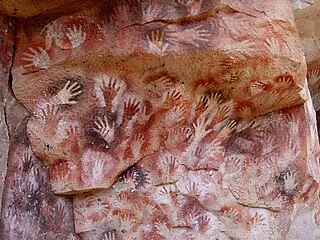
In archaeology,cave paintings are a type of parietal art,found on the wall or ceilings of caves. The term usually implies prehistoric origin. These paintings were often created by Homo sapiens,but also Denisovans and Neanderthals;other species in the same Homo genus. Discussion around prehistoric art is important in understanding the history of the Homo sapiens species and how Homo sapiens have come to have unique abstract thoughts. Some point to these prehistoric paintings as possible examples of creativity,spirituality,and sentimental thinking in prehistoric humans.
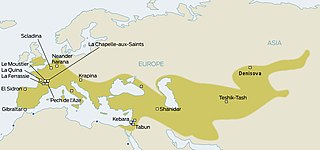
The Mousterian is an archaeological industry of stone tools,associated primarily with the Neanderthals in Europe,and to the earliest anatomically modern humans in North Africa and West Asia. The Mousterian largely defines the latter part of the Middle Paleolithic,the middle of the West Eurasian Old Stone Age. It lasted roughly from 160,000 to 40,000 BP. If its predecessor,known as Levallois or Levallois-Mousterian,is included,the range is extended to as early as c. 300,000–200,000 BP. The main following period is the Aurignacian of Homo sapiens.
The Châtelperronian is a proposed industry of the Upper Palaeolithic,the existence of which is debated. It represents both the only Upper Palaeolithic industry made by Neanderthals and the earliest Upper Palaeolithic industry in central and southwestern France,as well as in northern Spain. It derives its name from Châtelperron,the French village closest to the type site,the cave La Grotte des Fées.

Les Eyzies-de-Tayac-Sireuil is a former commune in the Dordogne department in Nouvelle-Aquitaine in southwestern France. It was created in 1973 by the merger of two former communes:Les Eyzies-de-Tayac and Sireuil. On 1 January 2019,it was merged into the new commune Les Eyzies.

The Upper Paleolithic is the third and last subdivision of the Paleolithic or Old Stone Age. Very broadly,it dates to between 50,000 and 12,000 years ago,according to some theories coinciding with the appearance of behavioral modernity in early modern humans,until the advent of the Neolithic Revolution and agriculture.
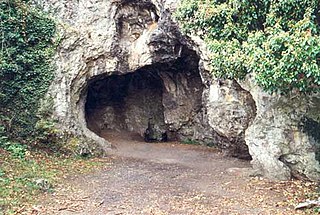
Spy Cave is located in Wallonia near Spy in the municipality of Jemeppe-sur-Sambre,Namur Province,Belgium above the left bank of the Orneau River. Classified as a premier Heritage site of the Walloon Region,the location ranks among the most significant paleolithic sites in Europe. The cave consists of numerous small chambers and corridors.
Henri Édouard Prosper Breuil,often referred to as AbbéBreuil,was a French Catholic priest,archaeologist,anthropologist,ethnologist and geologist. He is noted for his studies of cave art in the Somme and Dordogne valleys as well as in Spain,Portugal,Italy,Ireland,China with Teilhard de Chardin,Ethiopia,British Somali Coast Protectorate,and especially southern Africa.

Prehistoric France is the period in the human occupation of the geographical area covered by present-day France which extended through prehistory and ended in the Iron Age with the Roman conquest,when the territory enters the domain of written history.
Harold Lewis Dibble was an American Paleolithic archaeologist. His main research concerned lithic reduction;he conducted fieldwork mainly in France,Egypt,and Morocco. He was a professor of Anthropology at the University of Pennsylvania and Curator-in-Charge of the European Section of the University of Pennsylvania Museum of Archaeology and Anthropology.
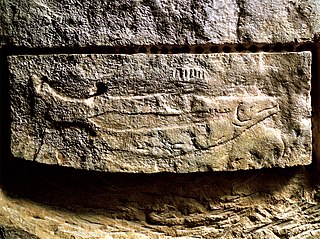
The Prehistoric Sites and Decorated Caves of the Vézère Valley is a UNESCO World Heritage Site in France since 1979. It specifically lists 15 prehistoric sites in the Vézère valley in the Dordogne department,mostly in and around Les Eyzies-de-Tayac-Sireuil,which has been called the "Capital of Prehistory". This valley is exceptionally rich in prehistoric sites,with more than 150 known sites including 25 decorated caves,and has played an essential role in the study of the Paleolithic era and its art. Three of the sites are the namesakes for prehistoric periods;the Micoquien,Mousterian,and Magdalenian. Furthermore,the Cro-Magnon rock shelter gave its name to the Cro-Magnon,the generic name for the European early modern humans. Many of the sites were discovered or first recognised as significant and scientifically explored by the archaeologists Henri Breuil and Denis Peyrony in the early twentieth century,while Lascaux,which has the most exceptional rock art of these,was discovered in 1940.

The details about Neanderthal behaviour remain highly controversial. From their physiology,Neanderthals are presumed to have been omnivores,but animal protein formed the majority of their dietary protein,showing them to have been carnivorous apex predators and not scavengers. Although very little is known of their social organization,it appears patrilines would make up the nucleus of the tribe,and women would seek out partners in neighbouring tribes once reaching adolescence,presumably to avoid inbreeding. An analysis based on finger-length ratios suggests that Neanderthals were more sexually competitive and promiscuous than modern-day humans.
Lynne Sullivan is an American archaeologist and former Curator of Archaeology for the Frank H. McClung Museum located on the University of Tennessee campus in Knoxville,Tennessee. A graduate of the University of Tennessee (undergraduate) and the University of Wisconsin–Milwaukee,Sullivan is renowned for her research and publications on subjects such as Southeastern United States prehistory,Mississippian chiefdoms,mortuary analysis,and archaeological curation. She has been a major contributor to the feminist/gender archaeology movement through her studies in social inequality,gender roles,and the historic significance of women in the development of modern archaeology.
Dust Cave is a Paleoindian archaeology site located in northern Alabama. It is in the Highland Rim in the limestone bluffs that overlook Coffee Slough,a tributary of the Tennessee River. The site was occupied during the Pleistocene and early Holocene eras. 1LU496,another name for Dust Cave,was occupied seasonally for 7,000 years. The cave was discovered in 1984 by Dr. Richard Cobb and initially excavated in 1989 under Dr. Boyce Driskell from the University of Alabama.
Charles Harrison McNutt III was an American archaeologist and a scholar of the prehistoric Southeastern United States. He conducted fieldwork and published works on the archaeology of the American Southwest and the Great Plains in South Dakota. His work emphasized on a strong understanding of cultural history and statistical analysis.
Jefferson Chapman is an archaeologist who conducted extensive excavations at sites in eastern Tennessee,recovering evidence that provided the first secure radiocarbon chronology for Early and Middle Archaic period assemblages in Eastern North America. He also is a research professor in anthropology and the Director of the Frank H. McClung Museum at the University of Tennessee,Knoxville. Chapman’s professional interests include Southeastern archaeology,paleoethnobotany,museology and public archaeology.

Le Regourdou is an archaeological site in the Dordogne department,France,on top of a hill just 800 m (2,600 ft) from the famous cave complex of Lascaux. At this now collapsed 35 m (115 ft) deep ancient karst cavity remarkably well preserved Neanderthal fossils were recovered,that might be skeletal remains of deliberate burials. According to the current excavation team at the site,the correct name of the location is "Regourdou". "Le Régourdou" is considered a misnomer and should be avoided.

Carolina Mallol was born in Barcelona,Spain in 1973,and is a professor and researcher of archaeological science at the University of La Laguna in Tenerife,Spain.

The Grotte de Gabillou also known as Grotte de las Agnelas is a cave in France in which prehistoric ornaments stemming from the paleolithic period exist. It is situated in the commune of Sourzac in the department of Dordogne,Nouvelle Aquitaine and is a private property. Its sediments are from the Maastrichtian era.
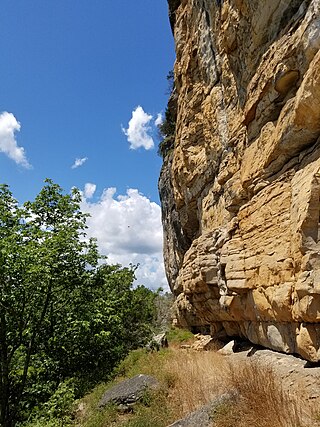
Painted Bluff is a cliff overlooking the Tennessee River in Marshall County,Alabama that features over 130 individual prehistoric Native American pictographs and petroglyphs. Painted Bluff is located about 4 miles (6.4 km) downstream from the Guntersville Dam and is only accessible by boat. The bluff is divided into three levels:the low ledge along the river,a middle ledge above it,and a high ledge near the top of the cliff face. A small cave is located along the low ledge.
The Ancient Art Archive (AAA) is a nonprofit organization dedicated to the preservation,visual documentation,and sharing of prehistoric works of art,particularly cave painting and petroglyphs,around the globe. The organization was founded in 2016 by photographer Stephen Alvarez following an assignment to photograph France's Chauvet Cave for National Geographic. As part of its mission to create and distribute 3D images of ancient artwork for educational purposes—many of which are threatened by climate change,mining operations,and vandalism—the Archive has launched the Mural of America,a collaboration of anthropologists,archaeologists,and Native American artists to document and provide cultural and scientific context to ten North American cultural landmarks. In 2022,members of the Archive team received wide media attention for their use of 3D photography in uncovering previously unseen cave art in Alabama's 19th Unnamed Cave.
References
- 1 2 3 4 5 Sullivan, John Jeremiah (March 20, 2011). "America's ancient cave art". Slate Magazine. Retrieved November 12, 2021.
- ↑ “Susan Tours Simek, mother of UT president Jan Simek has died”. University Relations. The Pacer. May 22, 2010.
- 1 2 3 4 5 “Neanderthals on Trial”. A NOVA Production by MDTV Productions, Inc. for WGBH/Boston. 2001 WGBH Educational Foundation. Public Broadcasting System.
- 1 2 Dr. Jan Simek Archived 2010-06-09 at the Wayback Machine , University of Tennessee Office of the President, accessed July 24, 2010
- ↑ Dr. Jan F. Simek Archived 2010-07-26 at the Wayback Machine , University of Tennessee Department of Anthropology, accessed July 24, 2010
- ↑ UT Knoxville Says Thanks to Jan Simek, January 30, 2009
- 1 2 3 4 5 6 1998. Simek, Jan F., Jay D. Franklin, and Sarah C. Sherwood. “The Context of Early Southeastern Prehistoric Cave Art: A Report on the Archaeology of 3rd Unnamed Cave”. American Antiquity 63: 663-677. https://www.jstor.org/stable/2694114
- ↑ Blakemore, Erin, These Treasures Are Hidden No More [ dead link ], National Geographic, Wednesday, May 4, 2022
- ↑ Pettitt, Paul and Pike, Alistair, Ancient Cave Art in Alabama May Be The Largest Ever Found in North America , The Connversations, May 4, 2022
- ↑ Marquis Who’s Who in America 2011- 65th Edition. Marquis Who's Who. October 2010.
- ↑ Purdy, Michael (17 November 2014). "Professor Awarded for Prehistoric Rock Art Research". The university of Tennessee Knoxville News. Retrieved 8 March 2024.